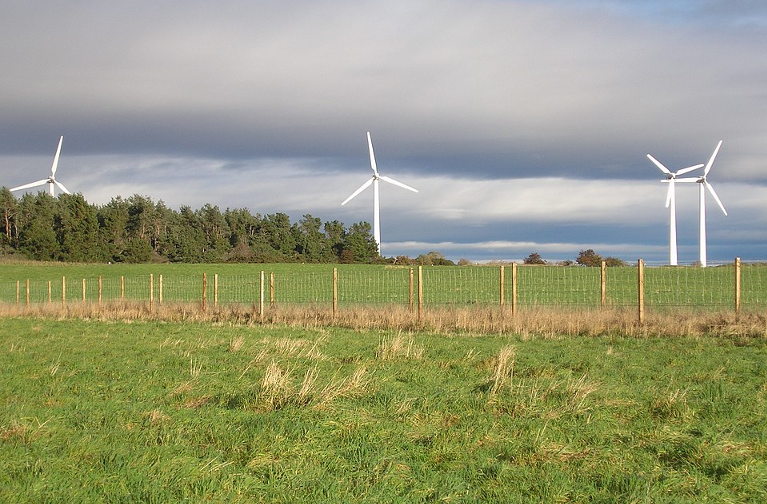Most people in the developed world are largely disengaged from the vast quantities of energy we consume. It has become a seamless part of everyday life. However, the source and means of energy production has become one of the most politically-charged questions of this century. As the climate crisis looms ever larger, how and where we produce our energy has mutated beyond being a question of energy policy and planning into one of the core debates society must address as we attempt to conceptualise a just transition from unchecked exploitation of the natural world.
Future vision
Proponents of community energy, or energy cooperatives, envision a future in which small-scale renewable energy infrastructure is owned and used by local communities. These groups operate in a way that enables them to adapt to local needs and function under principles of direct democracy. Whether focusing on the installation of solar-PV or ground-source heat pumps, education campaigns or energy e!ciency schemes, they come in a variety of forms but are united by the joint goals of decentralisation and decarbonisation.
Often, cooperatives such as BHESCo, based in Brighton, will use revenue created from generation to run campaigns to tackle energy poverty and provide vulnerable people with information on dealing with energy companies. The idealistic apogee of this idea is a future in which a decentralised network of grassroots actors provide not only for the energy needs of their local area but also create a democratic and participatory community, which in turn provides solutions for problems beyond the question of where and how our energy is produced.
Dismantling the centralised grid and challenging the monopoly of the carbon industry is a daunting, almost utopian prospect. Community Energy England’s 2019 report on the sector found that there were 275 community energy groups across the UK, but in 2018 only three new groups were formed. When looking at the spread of community energy in the UK, we only need to consider our neighbours in northern Europe to understand the relative weakness of our sector. In Germany, 50 per cent of renewable energy capacity is owned by communities, while in Denmark up to 80 per cent of wind turbines are community-owned.
Why has community energy seen great success in Denmark? One reason may be found in the nature of political decision making, which involves a more consensual process, with diverse actors forming policy at the highest level. This filters down through municipalities, which operate with a significant degree of autonomy to provide local solutions with the involvement of local people. Similarly, in Germany the interaction between citizens, companies and municipalities has led to the formation of more than 1,000 community energy groups. In 2016, only 5.4 percent of renewable energy infrastructure was owned by the ‘big four’ energy suppliers. This shows how, moving forward from the UK’s current system of almost total dependence on multinational energy companies, an effectively supported community energy sector can challenge existing forms of dominance. It seems apparent that a rigid and centralised political system such as the one in the UK stifles the scope of community organising. The UK suffers not from a lack of interest in alternative models of energy production but from an energy market structured to perpetuate the dominance of powerful and established actors at the expense of smaller and more diverse groups.
A difficult future
A number of policy changes by successive governments in the UK have placed a stranglehold on this fledgling sector. From 2015, the government began to remove the feed-in-tariff system, which provided a guarantee that small-scale producers would receive an income for the energy they produced. These changes saw new projects stall for almost half of UK community energy groups. New installations of small-scale solar capacity dropped by 74 per cent in 2016. The industry was further weakened by the removal of grant schemes such as the urban community energy fund, which provided seed money for new projects.
This is a symptom of a wider sickness in British politics – an almost unparalleled level of centralised political and bureaucratic control. Take this in combination with an obsessive drive for the creation of fully liberalised markets wherever they can be formed, and it is easily understandable why community energy has remained a small niche in the UK. The survival of the sector has begun to rely on crowd-funding investment platforms such as Ethex to funnel money into projects. This places what was once an exercise of decentralised democracy into another market structure, and begins to channel the co-benefits created by community-run projects away from the communities themselves.
Fragile system
The shock of the Covid-19 pandemic exposed the fragility of a system dependent on centralised decision making. In the initial weeks of the crisis in the UK, at the national level, there was a notable lack of action to support workers and communities. It has been at the local level that innovative and appropriate solutions have arisen. The blossoming of a network of mutual aid groups has spearheaded efforts to ensure that people are receiving essentials and aren’t left without social contact while in isolation. At a time when people are potentially more isolated than ever, there is a renewed sense that our communities are our last line of defence in times of crisis.
In the UK, the government has created an adversarial environment for the community energy sector, but it hasn’t closed down the possibility for the development of community innovation and the strengthening of resilience at the local level. As demonstrated elsewhere in Europe, community and cooperative energy has a crucial role to play in disrupting the monopolies of energy production. It is only through significant pressure to change the structure of our political system, or through mass community mobilisation, that there is any hope of breaking the back of the traditional carbon infrastructure that is dragging us past the tipping point of climate catastrophe.
Teaser photo credit: By W. L. Tarbert – Own work, Public Domain, https://commons.wikimedia.org/w/index.php?curid=1336888





